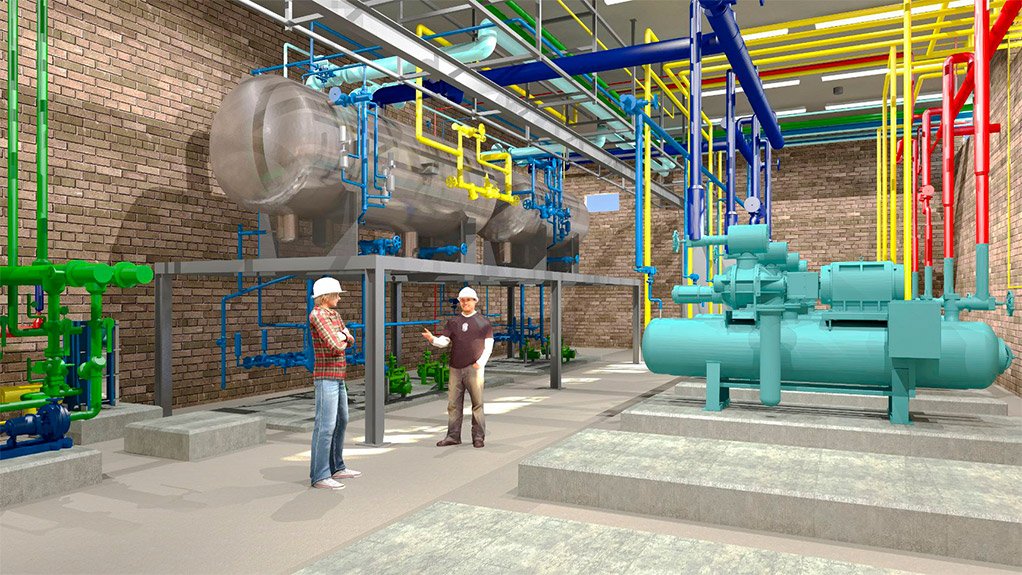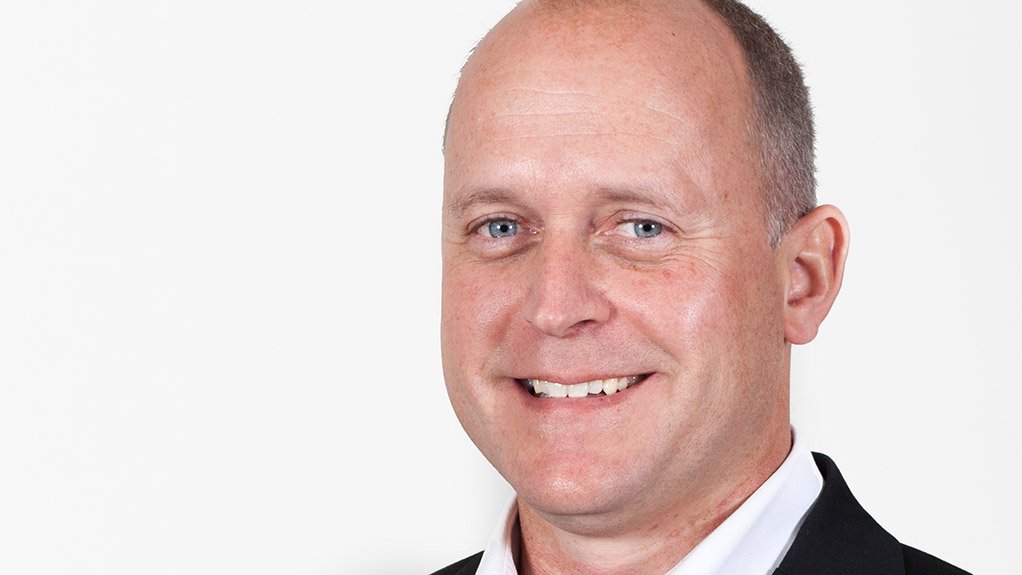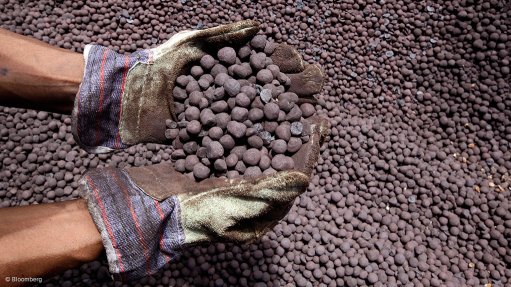Preliminary design of refrigeration system concluded



3D MODELLING Using the 3D modelling software complete with associated engineering data helped to prevent the project from stalling
Photo by Orange Ink
KOBUS DE VILLIERS It is extremely important that our clients maintain the systems we put in place to achieve the energy efficiencies WSP aims for
Photo by Orange Ink
Engineering and design company WSP Africa completed the preliminary design of an ammonia-based refrigeration system for Malaysian retailer Giant in June this year.
WSP technical director Kobus de Villiers notes that the project has been delayed by three months, as the project team had to wait for the architectural designs to be completed to allow the detailed design phase to start.
This phase is expected to be complete by the end of this month and he adds that the system should be commissioned in the next 14 months.
De Villiers tells Engineering News that the design of the refrigeration system provides an opportunity for the project team to incorporate a water heating system for the heating mats, which prevent the floors of the refrigeration system from freezing.
De Villiers points out that there are three temperature classes in the refrigeration industry. Low temperature (LT) refers to products that need to be kept below –15 ºC. Products that need to be stored between 0 ºC and 10 ºC are categorised as medium temperature (MT), while products that need to be maintained between 10 ºC and 15 ºC are deemed high temperature.
The LT cascade refrigeration requirement for the Giant system is a 650 kWR ammonia load, which can achieve a coefficient of performance (COP) of 5.8. This means that, for every kilowatt of electrical energy used, 5.8 kWR of refrigeration energy is produced or generated.
“The estimated water requirement for the production areas is about 11 000 ℓ/d; however, owing to the heat-reclamation system, no electrical energy is used to generate the hot water needed for production,” De Villiers highlights.
The MT system has an ammonia refrigeration load of 3 400 kW and runs at a COP of 5.5.
A refrigeration system operates like a combustion engine running in reverse, with a significant amount of pressured gas that needs to be worked against in the system, De Villiers explains, adding that the more you can reduce the pressure difference you are working against, the lesser the energy it takes to achieve the same cooling effect.
“As long as the condenser is big enough, which we try to oversize as much as practically suitable, you can establish massive energy savings, providing opportunities to redistribute the energy elsewhere.”
Monitoring refrigeration systems enables WSP and its clients to actively measure and, where possible, actively reduce the condensing pressures in the system, which, in turn, boosts refrigeration potential, resulting in significantly reduced pressures without having to change any of the capital equipment, he explains.
“However, it is extremely important that our clients maintain the systems we put in place to achieve the energy efficiencies WSP aims for. This normally involves putting a monitoring system or procedure in place, but if, in turn, the system is not monitored, then the opportunities for energy saving will be lost or greatly reduced,” De Villiers maintains.
He points out that designing a robust, efficient refrigeration system that can be easily operated is one of the most pressing challenges that engineers face. “We facilitate training for our clients to effectively use monitoring systems. However, the people involved in training are normally operating only one site and, should that person leave the company or be relocated, there is often no one else who could effectively use the monitoring system.”
De Villiers adds that standardisation of retailers’ refrigeration and associated monitoring systems is another challenge that engineers face, as training is needed for each system if not standardised.
Meanwhile, WSP has been involved in a 15 000 m2 expansion project at South African retailer Shoprite’s Centurion-based distribution centre, since the project’s inception in 1999. The project has seen a total expansion of 35 000 m2 to date.
“We were allowed to provide most of the engineering services for this project, so the integration of the systems went very well, as we modelled the installation using three-dimensional (3D) software instead of drawing it,” De Villiers highlights.
WSP used virtual walkthrough 3D software Navisworks, backed by design packages such as Revit MEP, for the project, which De Villiers says made it easier to plan a more efficient solution and facilitated coordination and clash prevention.
He explains that, for example, the software enabled WSP to design and coordinate, in a complex environment, a condensation harvesting solution which reclaims otherwise wasted condensate moisture in the air through the refrigeration coolers. The reclaimed water was then routed into the refrigeration system cooling towers, which use water to keep head pressure low.
“This solution significantly reduced the amount of water required to maintain operations,” De Villiers says, adding that the reclaimed water is treated, as its purity makes it corrosive.
He concludes that using the 3D modelling software, complete with associated engineering data, such as structural weights and rigidity, helped to prevent the project from stalling, as all the necessary data was readily available in a real-time collaborative space.
Property market
In other news, WSP Africa and consulting engineering firm RPP and SPN Consulting Engineers joined forces in April to supplement WSP’s existing heating, ventilation and air conditioning and mechanical engineering capability in Johannesburg, while joining one of the largest multidisciplinary engineering consultancies in Africa enables RPP to grow with WSP’s global skills network as backing.
RPP’s and SPN’s full team of experts have relocated to WSP’s head office in Bryanston, Johannesburg, where they continue to service existing agreements seamlessly. “We will carry across all our core values and high design standards, and we look forward to joining a well-respected international consultancy. “WSP has always been a big player in the property market. We will to continue to serve our clients to the high standards to which they are accustomed with this global reach at our disposal,” says RPP Consulting Engineers former principal and new WSP building services director Pieter de Bod.
Shared values, such as a passion for sustainability and innovation, have seen WSP and RPP make an impressive impact on the South African property sector in recent years. Working together on several high-profile projects, including the Steyn City parkland residence, in northern Johannesburg, and Maxwell Office Park, in Midrand, the companies have complemented and supported each others’ skills sets to deliver best-in-class solutions for their clients.
South African financial institute Standard Bank’s recently completed office complex in Rosebank, Johannesburg, is a further example of collaboration and teamwork. WSP’s well-respected Green by Design team provided green building consulting services that led to the complex receiving a five-star design rating from the Green Building Council of South Africa, while RPP provided cutting-edge trigeneration designs to support the receipt of this rating.
“Former RPP employees De Bod, Werner Broers, Jay Naidu and their team brought our building services division head-count in South Africa to over 160 people, ensuring we continue to offer our clients the services of highly skilled and qualified engineers that are passionate about design, buildings and delivering projects on time and to specification every time,” concludes WSP Africa building services MD Peter Hodgkinson.
Comments
Press Office
Announcements
What's On
Subscribe to improve your user experience...
Option 1 (equivalent of R125 a month):
Receive a weekly copy of Creamer Media's Engineering News & Mining Weekly magazine
(print copy for those in South Africa and e-magazine for those outside of South Africa)
Receive daily email newsletters
Access to full search results
Access archive of magazine back copies
Access to Projects in Progress
Access to ONE Research Report of your choice in PDF format
Option 2 (equivalent of R375 a month):
All benefits from Option 1
PLUS
Access to Creamer Media's Research Channel Africa for ALL Research Reports, in PDF format, on various industrial and mining sectors
including Electricity; Water; Energy Transition; Hydrogen; Roads, Rail and Ports; Coal; Gold; Platinum; Battery Metals; etc.
Already a subscriber?
Forgotten your password?
Receive weekly copy of Creamer Media's Engineering News & Mining Weekly magazine (print copy for those in South Africa and e-magazine for those outside of South Africa)
➕
Recieve daily email newsletters
➕
Access to full search results
➕
Access archive of magazine back copies
➕
Access to Projects in Progress
➕
Access to ONE Research Report of your choice in PDF format
RESEARCH CHANNEL AFRICA
R4500 (equivalent of R375 a month)
SUBSCRIBEAll benefits from Option 1
➕
Access to Creamer Media's Research Channel Africa for ALL Research Reports on various industrial and mining sectors, in PDF format, including on:
Electricity
➕
Water
➕
Energy Transition
➕
Hydrogen
➕
Roads, Rail and Ports
➕
Coal
➕
Gold
➕
Platinum
➕
Battery Metals
➕
etc.
Receive all benefits from Option 1 or Option 2 delivered to numerous people at your company
➕
Multiple User names and Passwords for simultaneous log-ins
➕
Intranet integration access to all in your organisation



















